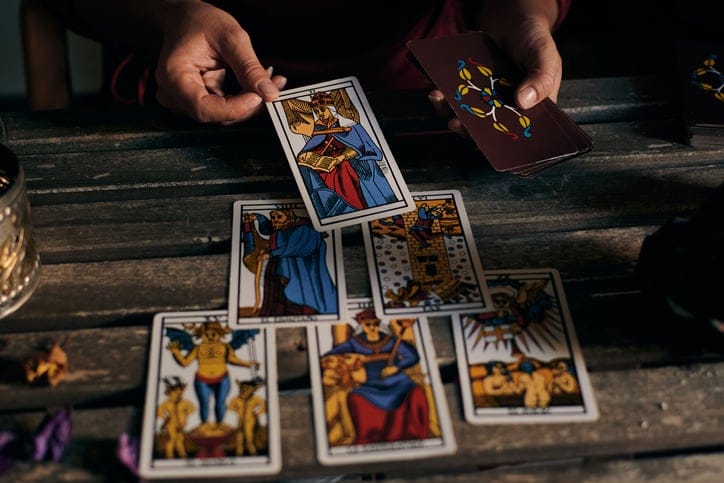If you’re someone who believes in astrology and spirituality, chances are you’ve had your tarot cards read before. Whether you went to see a professional card reader or you had a friend do it, you might have learned something interesting about yourself or got the answer to an important question. But what if you don’t have anyone to do a spread for you but you’d still like to consult the cards? Here’s how to do a tarot card reading for yourself.
Can you read your own tarot cards?
Definitely! While there are places online to get a free tarot reading, it’s totally possible to do a tarot card reading for yourself. Many people use tarot cards as a tool for self-reflection, guidance, and insight. In fact, some people prefer doing their own readings because it allows them to focus on specific questions and concerns without the distraction and input from the reader.
To do a tarot reading for yourself, you’ll need a tarot deck and a basic understanding of the meanings of the cards. There are plenty of resources that explain tarot card meanings online, and many decks come with booklets explaining it. It’s also important to set an intention for the reading and to approach the process with an open mind and a willingness to be honest with yourself. Otherwise, the whole thing is pointless.
When doing a reading for yourself, it’s important to stay objective and not let what you want or what you’re afraid of influence the interpretation of the cards. It can be helpful to take a few deep breaths, clear your mind, and focus on your question before you start shuffling the cards. The calmer you are, the clearer the reading will be.
After you’ve shuffled the cards and drawn them, take your time to interpret each card and how it relates to your question or situation. You can use your intuition, knowledge of tarot symbolism, and any resources, such as tarot guidebooks or online resources, to help you interpret the cards.
Remember that tarot readings don’t have meanings that are set in stone. They’re only a reflection of the energies and possibilities that exist in the present moment. The insights gained from a reading can help you make more informed decisions and gain clarity on your situation, but don’t let it control your life.
How to do a 3-card tarot reading for yourself
- Choose a deck. It’s important to choose a tarot deck that resonates with you. There are many different types of tarot decks available, so take your time. Maybe you really like the artwork on a certain deck, or the colors really stand out to you. You can also consider selecting a deck that matches the kind of question you have in mind. Pick one that feels right.
- Decide on a question. Once you pick a deck, decide on a question that you’d like help answering. Your question should be specific and clear. Avoid asking yes or no questions, as these tend to limit the scope of the reading. Instead, ask open-ended questions that can provide you with deeper insights. Also, go into the reading knowing that you will not get a definitive answer but rather help and guidance.
- Shuffle the cards while thinking of your question. Make sure to shuffle the deck thoroughly and slowly. Take your time to connect with the energy of the deck and allow your intuition to guide you as you shuffle.
- Draw three cards. Once you feel ready, draw three cards from the deck. You can lay them out in a row, with the first card representing the past, the second card representing the present, and the third card representing the future. If you’d like, you can lay the cards out in a triangle formation, with each card representing a different aspect of your question.
- Interpret the cards. Interpret each of the three cards, using your intuition and the symbolism of the cards to guide you. Start with the first card, and consider its meaning in relation to your question. Then, move on to the second card, and finally the third. Pay attention to the imagery, colors, and numbers on the cards, and consider how they might relate to your question. If you struggle to remember a card’s meaning while doing this, feel free to look it up.
- Reflect on the reading. Once you’ve interpreted all three cards, take some time to reflect on the reading. Consider how the cards relate to your question and what insights they’ve given you. Take note of any emotions, thoughts, or feelings that come up for you during the reading.
- Take action. You can use what you learned from doing your own tarot card reading to spur you into action.The tarot is a tool for self-reflection and personal growth. Whether it’s changing your perspective, taking a new approach, or making a concrete plan of action, use what you’ve gleaned from the reading to move forward.
How to do a 5-card tarot reading
Doing a 5-card tarot reading for yourself is very similar to a 3-card reading, with a few differences. Here’s how to do it.
- Set the intention. Before you start, you need to set an intention for the reading. What are you hoping to get from it? You might want to gain insight into a particular situation, understand your current path, or seek guidance on a decision. Whatever your reason for doing the reading, have it in mind before getting started.
- Shuffle the deck. Shuffle the deck of tarot cards, focusing on your intention as you do. You can do this however you want, just make sure the deck is thoroughly shuffled and keep your intention in mind as you’re doing it.
- Draw the cards. Once you’ve shuffled the deck, draw five cards from the deck. You can lay the cards out in a row or a pattern that feels intuitively right to you. There are plenty of 5-card tarot spreads for beginners that are simple to do.
- Interpret the cards. Interpret each card one by one. Start with the first card and consider how it relates to your intention. Then move on to the second card, etc., until you’ve interpreted all five cards.
- Consider the card positions. When you lay out the cards, you might want to assign each card to a specific position. For instance, the first card could represent the present situation, the second card could represent obstacles, the third card could represent opportunities, the fourth card could represent advice, and the fifth card could represent the outcome. However, you can assign the positions based on your intuition and the question you asked.
- Look at the relationships between the cards. Once you’ve interpreted each card, look at how the cards relate to each other. Notice any patterns, similarities, or contrasts between the cards. The relationships between the cards can provide additional insights into your question.
- Reflect on the reading. After you’ve interpreted all the cards and considered their relationships, take some time to reflect on the reading. Think about how the cards provide insight into your question, and how you can use that insight in your life.




